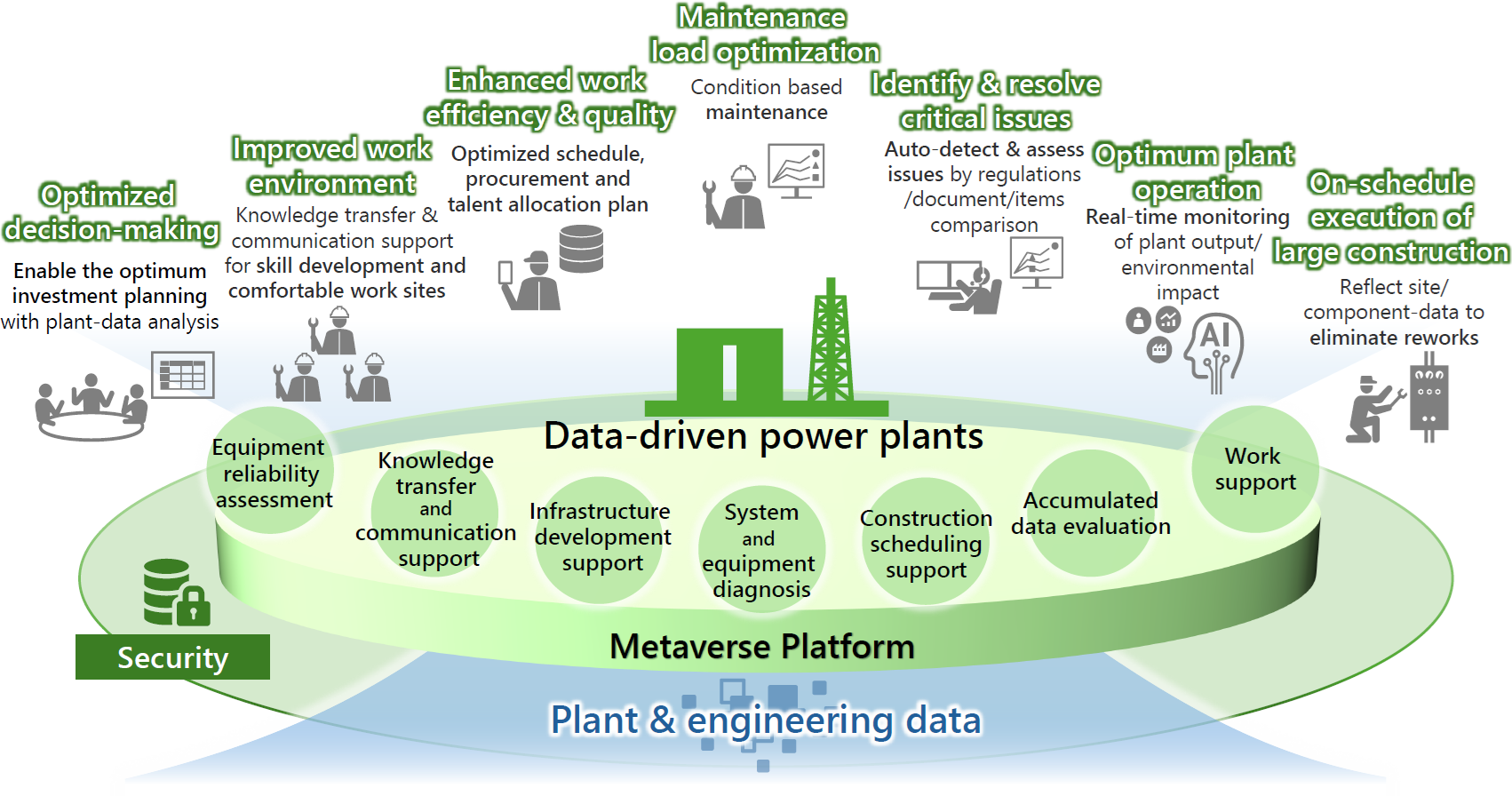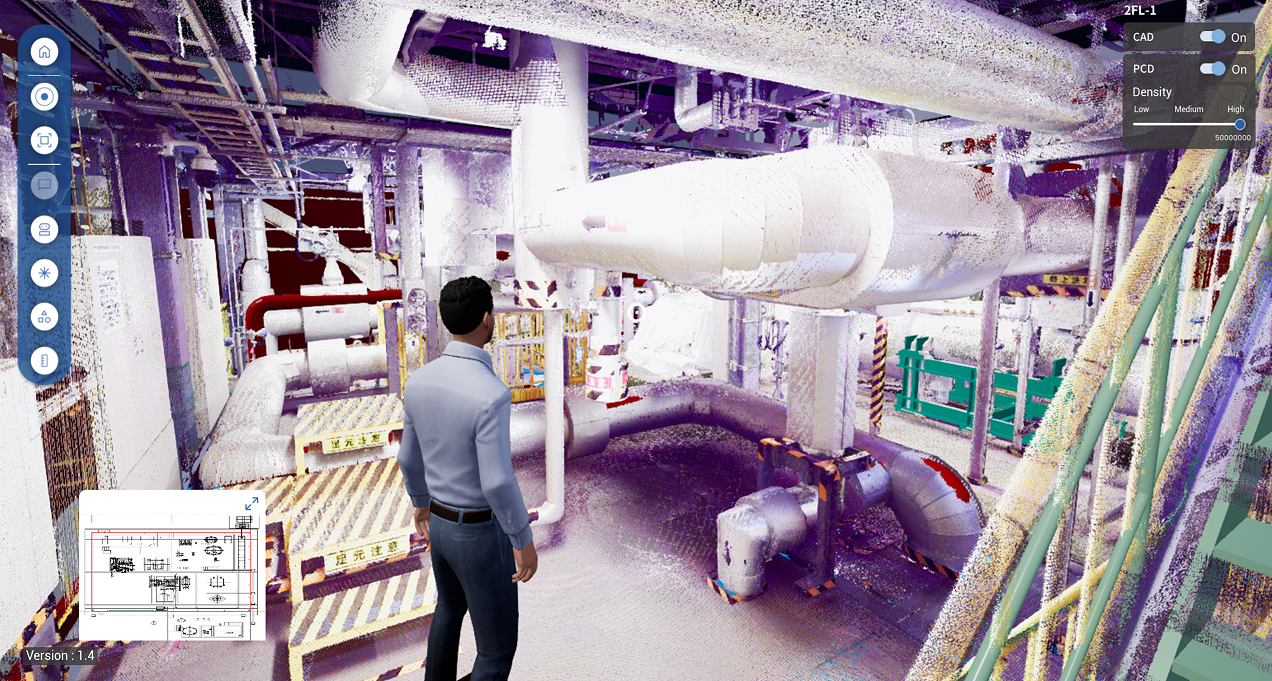
Nuclear energy is now attracting renewed attention for its role. With global warming becoming increasingly serious, there are expectations that nuclear energy will be the base-load power source for its stable output and high level of autonomy, in addition to its being a decarbonized power source that does not emit CO2 during generation. On the other hand, declining birthrates, aging population and labor shortages are rapidly advancing in Japan, and the nuclear energy industry also faces the urgent challenges of how to address human resource shortages and ensure knowledge transfer.
In response, the Hitachi Group is working to solve these challenges with digital technology while supporting the safe and reliable operation of nuclear power plants. Leading those initiatives is Masaaki Osaka, Senior Chief Engineer and General Manager of Digital Innovation Division at Hitachi-GE Nuclear Energy, Ltd. We asked him about the latest efforts and the future prospects in the development of digital technologies and services related to nuclear energy.
――There are growing expectations for nuclear energy as we target carbon neutrality by 2050. Why is the use of digital technologies in nuclear energy now a necessary part of that?
Nuclear power generation requires advanced technologies and knowledge. However, as you are aware, many nuclear power plants stopped operating in Japan after the Great East Japan Earthquake on March 11, 2011, and over that period of more than a dozen years, experienced workers with advanced technical expertise and knowledge gradually retired. Furthermore, it is expected that the decrease in the working population due to the declining birthrate and aging population will continue in the future. In the Hitachi Group's nuclear energy business, although we are hiring new graduates and experienced personnel, the knowledge transfer from experienced engineers and the improvement of productivity have become challenges. Now, as expectations for nuclear energy are rising significantly toward carbon neutrality, Hitachi is working to solve those urgent challenges with Lumada*.
* Lumada is Hitachi’s advanced digital solutions, services, and technologies for turning data into insights to drive digital innovation.
――Are there any tasks that have increased for supporting restart of nuclear power plants?
Yes. Construction for additional safety measures is underway at each nuclear power plant to comply with New Regulatory Requirements for restarting reactors. This is why the workload has increased not only for the engineers responsible for designing hardware, but also for the frontline workers responsible for tasks such as installing the equipment on site.
Ahead of this situation, Hitachi has already been working on knowledge transfer, utilizing digital technologies. For example, we record video of experienced employees executing work and utilize it to train younger workers, and digitize manuals from printed book form so that they can be viewed on tablets. From 2017 in particular, we have developed a knowledge transfer system and have been implementing knowledge management in an organized and systematic manner. However, to maintain and realize high quality infrastructure and services even with limited resources, I believe it is necessary to improve the productivity of frontline workers and develop environments where they can work energetically, making use of advanced digital technologies even more than before.
With that in mind, we are working to develop new digital tools that fit the digital native generation by utilizing digital technologies, along with technologies and solutions aimed at supporting the work performed not only by Hitachi but by the electric utility companies, our customers.
――What are the things that Lumada can make possible?
First, I would like to introduce you to a future concept of "data-driven power plant." Based on a digital twin platform which recreates a power plant in a virtual space utilizing metaverse technologies, this will provide value and solve issues by leveraging data to address the various needs and challenges of electric utility companies. We envisage iterating on a Lumada growth cycle where we collect and consolidate on-site data, evaluate it, create systems and solutions, implement and reflect those results on-site, and then collect data again.

Conceptual image of a data-driven power plant
For example, one of the needs of electric utility companies is to complete large-scale construction on schedule. Failing to complete construction within the planned shutdown period of a nuclear power plant can affect the plant’s operation rate. Given this, if we can access real-time on-site information, we will be able to develop more detailed plans in advance, which will help ensure that construction is carried out on schedule. Another need is optimizing the maintenance load, which we can help customers to achieve by utilizing data on the condition of equipment. For instance, if we can understand through the data that there are no signs of deterioration after equipment has been operating to a certain degree, we can make decisions such as using it for another cycle. This allows us to ensure safety while performing maintenance work at the optimum timing. In this way, we want to be able to make various decisions based on the data, which we refer to as "data-driven."
As a manufacturer, having shared data related to nuclear power plants allows us to engage in co-creation activities with customers and propose new solutions through such efforts. In addition, if we can create highly accurate schedule based on data, it will help us level out resource utilization and improve the productivity of frontline workers.
――What kind of data is expected to be used?
We have already been collecting a wide variety of data such as sensor data and operation & maintenance (O&M) data and utilizing it for condition monitoring, preliminary detection and so on, but we are also starting to use data that was not available before. One example we are currently working on is research and development into the deterioration of organic materials such as rubber, one of the consumable goods used at nuclear power plants. At a nuclear power plant, degradation occurs not only due to normal wear and tears but also for reasons specific to nuclear power generation. However, there is not much data available on this. Therefore, we are conducting research to improve performance of prediction by comparing it with on-site data, aiming to make it usable as decision-making criteria.
――What background led to the development of the metaverse technologies that will be the basis for data-driven power plants?
A metaverse technology we are developing is the core of data-driven power plants that will be widely utilized not only for meeting planned schedules but also for wider purposes of plant construction and operation.
As I mentioned earlier, with the continued shutdown of nuclear power plants, knowledge transfer has become a challenge for the entire industry. I see the metaverse as an extremely effective tool for addressing this issue using digital technologies.
In addition, in the installation of new equipment and the upgrades of existing equipment that Hitachi carries out at nuclear power plants, accurate construction planning and reliable execution are needed to ensure that on-site work is completed within the shortest possible schedule. On the other hand, access to nuclear power plants is restricted during their operational period, so the actual time and number of on-site surveys that can be conducted are limited. Now, we are working to adopt metaverse technologies so that we can accurately determine the latest on-site conditions even under those restrictions.

Masaaki Osaka
Senior Chief Engineer and General Manager of Digital Innovation Division, Hitachi-GE Nuclear Energy, Ltd.
――Are there difficulties unique to nuclear power plants?
I had a struggling experience myself when I was younger. Around 20 years ago, there was a need for large-scale renovation work of the domestic BWR (Boiling Water Reactor) nuclear power plants the Hitachi Group was responsible for. However, while the plant was operational, we were not allowed to enter important facilities within the plant. Despite needing to perform large-scale site work within a set period of time during the next regular inspection, we were not able to see the site in advance, and we still had to design the critical equipment under this circumstance. In fact, when we delivered the equipment to the site, there were issues such as pipe interference that we had not been able to grasp from drawings, and we were forced to address those issues on the spot.
Based on that experience, for many years I had wanted a tool that would allow us to accurately plan on-site work without having to go there beforehand. Recently, I learned that young engineers are facing similar challenges in work to implement safety measures for the restart of nuclear power plants, and I thought that what was impossible 20 years ago could now be addressed using digital technologies like the metaverse.
I suggested to the young engineers the idea of using the detailed design information (3D CAD) and point cloud data (site images) maintained by Hitachi to create a metaverse and make it accessible to everyone. They said, "this would be something we want to use." Following this, from around November 2023, we began detailed discussions with GlobalLogic, a member of the Hitachi Group that specializes in digital engineering services.
――Could you elaborate on collaboration with GlobalLogic?
GlobalLogic is headquartered in Silicon Valley, but we were joined by their delivery team based in India. Being a pure play R&D software development house with Silicon Valley mindset, their methodology is truly agile: after about 8 weeks of the discovery phase, requirements were defined, and we entered the implementation phase. In the implementation phase from around May 2024, the first prototype was released about 3 months later. After that, we repeated the process of having the results produced every 2 weeks, evaluating them, and giving feedback. As is standard with any agile methodology at GlobalLogic, product evaluation & user feedback is provided for refinement during the next product release. Within about 6 months, the metaverse space was ready for verification.
From around October 2024, we started the phase of building the metaverse space for the nuclear power plant based on the program created by GlobalLogic. It is expected to be ready for practical use in the first half of 2025. By combining the metaverse with generative AI, not only will it be possible to design and verify new piping, cables, and equipment installation routes and check welding spaces remotely in the metaverse space, but it will also be possible to search and view necessary related information on the spot. As a result, we expect to reduce the workload of on-site checks and reduce the risk of process delays by preventing design delays. In the future, we would like to create an environment where multiple engineers and customers can enter the metaverse space together as avatars, hold meetings on the spot, and create and paste the minutes using generative AI.

The image of the space generated with the newly developed metaverse technology
――Are there other examples of digital technologies expected to be utilized in the maintenance of nuclear power plants?
For the past four or five years, we have been developing an application called HAPPS (Hitachi Advanced Plant Performance Diagnosis System) for performance diagnosis of equipment and system. We are currently at the stage of conducting Proof of Concept (PoC) for performance diagnosis of heat exchangers at nuclear power plants.
There is also an application called Lumada APM developed by Hitachi Energy. APM is an acronym for Asset Performance Management. It is software that visualizes the status of equipment and constantly monitors equipment performance degradation and equipment abnormalities during operation. We expect that, for example, the combination of using HAPPS data as input and performance management with Lumada APM could contribute to the advancement of maintenance efficiency in various plants.
In relation to the metaverse, the Hitachi Group has already developed a technology known as the "Worksite-Augmenting Metaverse." The feature of this technology includes the ability to collect on-site data linked with 5W1H (when, where, who, what, why, how) information and to extract necessary information from accumulated data in a conversational format using generative AI.
In the future, we are considering building a platform that can address various needs by integrating these multiple applications with the metaverse technology currently under development and offering it to customers as a subscription-based service.
――As we advance digital transformation in the nuclear energy business, what unique strengths does the Hitachi Group possess?
The Hitachi Group has been engaged in the nuclear energy business since the 1950s, designing and manufacturing key equipment for nuclear power plants in various places. As such, we have accumulated extensive knowledge in nuclear energy. In addition to this, we can leverage the expertise of the colleagues within the Hitachi Group, who specialize in IT, and operational technologies (OT) such as operation and control. In other words, I believe our strength lies in our ability to integrate the three elements of IT, OT and products, and leverage that in the nuclear energy business through working together as "One Hitachi."
――What kind of talents would you like to join your team in the future?
We welcome those who are forward-thinking, who are highly motivated to learn and grow. We already have in place a system to pass on technical expertise from experienced employees to the next generation and going forward we will make use of even more advanced digital technologies, such as making the data accessible through the metaverse space we are currently developing, as part of our continued efforts on talent development and knowledge transfer.
As expectations for nuclear energy rise in the pursuit of carbon neutrality, we will continue to fully leverage the power of digital technologies as One Hitachi to contribute to safe and reliable operation, and to foster trust in nuclear power generation.